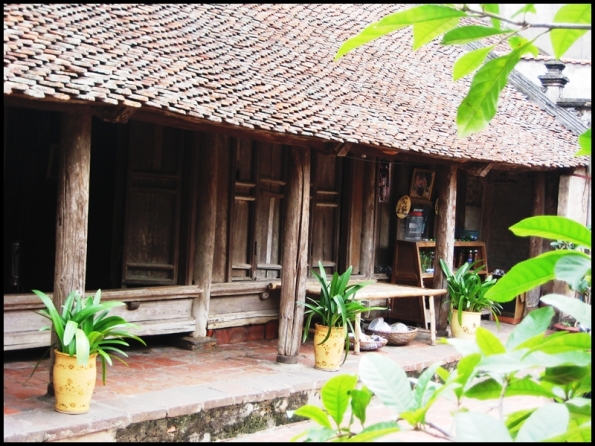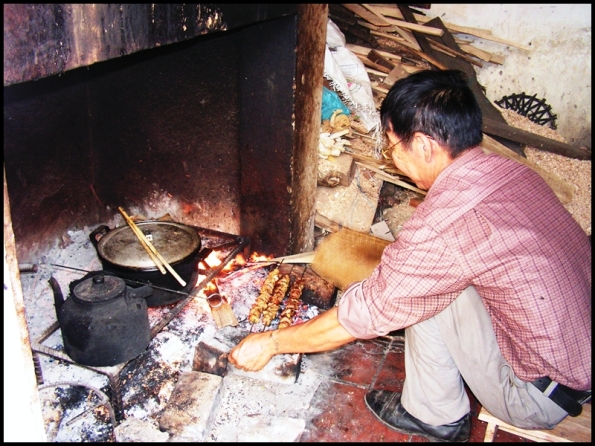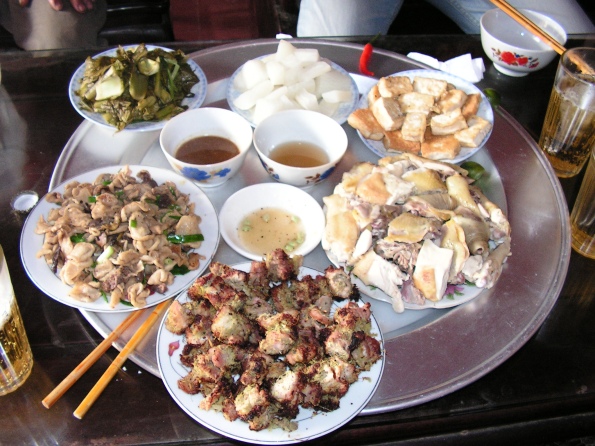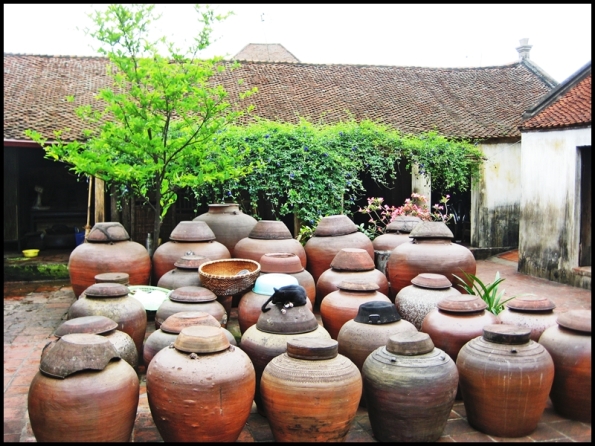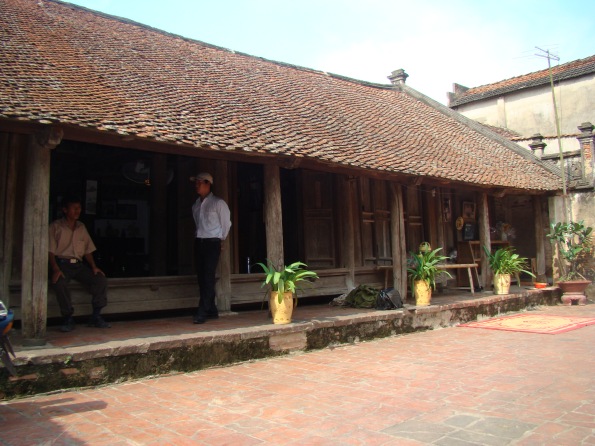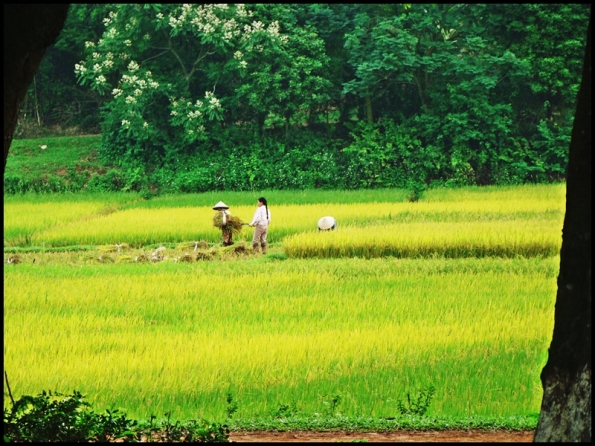Ong Cong, Ong Tao – Vietnam’s Day of the Kitchen Gods
Origin
‘Tao Quan’, ‘Ong Cong’ and ‘Ong Tao’, in Vietnamese belief, originated from the 3 Gods of the land (Tho Cong, Tho Dia and Tho Ky). from Taoism in China. When coming to Vietnam, the legend became the story of “2 Husbands and 1 wife” – the God of Land, God of House and God of Kitchen. However, people still call them “Tao Quan” or “Ong Tao”, because of a TRILOGY theory which is very popular in Eastern Belief and religion. The kitchen of a house where there is fire and both are based on earth or soil for building of the house.

In Vietnam, the story of Ong Cong, Ong Tao has been told through the generations, and then later it was written down so there are many different variations. But the main story for Vietnam is as follows:
Mr. Trong Cao had been married to Mrs Thi Nhan for a long time but they didn’t have any children. Then used to get upset and quarrels were often seen in their family.
In one of their arguments, Trong Cao, got really angry and beat his wife, Thi Nhan who left the home and later married another man named Pham Lang.
When Trong Cao realised he was wrong, he went out to look for his wife. He then spent all his money looking but couldn’t find her. Trong Cao became a beggar because he had spent all of his money.
One day, Trong Cao arrived at Thi Nhan’s house to beg, and they recognized each other. Thi Nhan felt sorry and regretted she had remarried to Pham Lang. Suddenly, Pham Lang came home and Thi Nhan found it hard to explain the situation., Thi Nhan asked Trong Cao to hide in the haystack out in the garden.
Back home, Pham Lang went in to the garden and burned the haystack to make fertilizer without noticing that Trong Cao was hiding there. Trong Cao didn’t dare to come out and was burned to death. Thi Nhan realised that Trong Cao was burning alive and jumped into the fire to die with him.
Pham Lang didn’t know what had happened, but he saw his wife had died and he followed her into the fire.
Their souls went to heaven and met the Jade Emperor. Jade Emperor understood their situation. Then entitled them to be known as, “Tao Quan”, which meant, ‘taking care of 3 different matters in the lives of people’s homes.’
– Pham Lang: was titled “Tho Cong”, taking care of Kitchens workings
– Trong Cao: was titled “Tho Dia”, Taking care of house workings
– Thi Nhan: was titled “Tho Ky”, taking care of food supply and shopping.
Worship:
Vietnamese people consider the 3 Gods watch and evaluate the good and bad things people have done, and they decide the prosperity of a family. Therefore, an altar to worship them is a must.

An altar for them is set near kitchen. Every year, on 23rd day of 12th month in Lunar Year calendar (in 2011, it is the January 26 on the western calendar); these Gods go for a meeting in heaven and report what people had done in the past year. Vietnamese people celebrate on this day. In the ceremony, the offering include a carp ship which is their transport, and 3 sets of traditional official paper dress hats, long dresses and shoes but no pants. This is because in the fire, their pants were burnt off.
Many Vietnamese families will buy 3 live fish, 1 female and 2 male, and release them into a river or pond and also burn paper clothes and money on the day.
Vietnamese Mother’s day
Vu Lan – Ullambana or Mother’s day
Vu Lan in Vietnamese is one of the main Buddhism festivals to show your gratitude to your mother. It is on 15th day of 7th month in Lunar Calendar.
Legend:
The Buddhist origins of the festival can be traced back to a story that originally came from India, but later took on culturally Chinese overtones. In the Ullambana Sutra, there is a descriptive account of a Buddhist monk named Maudgalyāyana, originally a brahmin youth who later ordained, and later becoming one of the Buddha’s chief disciples. Mahāmaudgalyāyana was also known for having clairvoyant powers, an uncommon trait amongst monks.
After he attained archonship, he began to think deeply of his parents, and wondered what happened to them. He used his clairvoyance abilities to see where they were reborn and found his father in the heavenly realms i.e. the realm of the gods. However, his mother had been reborn in a lower realm, known as the Realm of Hungry Ghosts. His mother took on the form of a hungry ghost (preta) – so called because it could not eat due to its highly thin & fragile throat in which no food could pass through, yet it was always hungry and it had a fat belly. His mother had been greedy with the money he’d left to her. He had instructed her to kindly host any Buddhist monks that ever came her way, but instead she withheld her kindness and her money. It was for this reason she was reborn in the realm of hungry ghosts.
Maudgalyāyana eased his mother’s suffering by receiving the instructions from feeding pretas and from the Buddha. The Buddha instructed Maudgalyāyana to place pieces of food on a clean plate, reciting a mantra seven times to bless the food, snap his fingers to call out to the deceased and finally tip the food onto clean ground. By doing so, the preta’s hunger would be relieved. Through these merits, his mother was able to be reborn. Buddha also tells people that they can perform the same kindness to show gratitude to their mothers.
Main activities:
For Buddhism followers, they will have a shower (so they will be clean for the ceremony) then go to a Pagoda to perform a spiritual ceremony. They worship their mother (if she has passed away) or ask the gods to give good health and happiness to their mother if she is still living. People, whose mothers have already died, will hang a white rose on their shirt and have a meal in pagoda (vegetarian) or at home honoring their deceased mother.
Cheers
Death Ceremony
Death anniversary
The death anniversary is a ceremony to commemorate a dead person in Vietnamese culture. It is held on the date of death according to the Lunar Calendar every year. It also reminds youngsters of their ancestors and to strengthen relationships between members of a family or of an occupational group.
Meaning:
The celebration of the death anniversary is an important day for Vietnamese people. It expresses faithfulness and compassion of living people towards dead people and to show filial respect to their ancestors. If you are wealthy, you can prepare a big party and invite your relatives and friends. If you are poor, a bowl of rice with salt, a boiled egg, incense and some simple foods are good enough. Your sincerity is not measured by how big a ceremony is. If you are a friend or relative of a dead person, you just go to death anniversary celebration without being invited.
Main activities:
Preparation will depend on a family’s financial status. Big parties will take longer while simple ones are easier to prepare. Nowadays, they will make, at least, a table of six. They will put all the food on a big tray and lay it down in front of an altar which has a picture of the dead person on it. Included on that tray, they put paper money (fake money that Vietnamese burn to send to dead people to help them buy things in the other life, a kind of quick Western Union money transfer) and rice wine. The dead persons name is written on the fake money and, when it is burnt, goes to a special depository for the deceased to pick up to use in the next life. The family also burns other paper and cardboard images of things they can use in the next life like cars, houses, horses and once a family member burnt a Boeing jet while his neighbor, not to be outdone, burnt a spaceship. The head of family will dress respectably; burn 3 incense sticks and make a prayer which shows his respect to the ancestor. (I use his as the head of family as it is always a man. If they don’t have a son then the eldest son in law will be in charge). They wait until the incense sticks burn up then they will burn the paper money and other paper or cardboard items. The paper money will be sent directly to the dead person so he or she can use it to make their way home.
After the ceremony, family members will eat the food that they offered in the ceremony. They eat and drink and talk to each other happily. After eating, the family will divide fruit and candy into small bags and give one to everybody who came to the ceremony.
Extra information:
– If for some reason they can’t hold the death anniversary on the date that their ancestor passed away, they have to pray on that day and explain why they cannot and ask for permission to move it to another date.
– The cost of the ceremony will be divided between all male members of the family, female members; including the son-in-law, can also put in money if they want to.
– The 1st anniversary will be as big as the funeral ceremony and they will invite a lot of relatives and friends to attend. Friends of the dead person will bring incense, paper money and some times an envelope with real money inside to help the family to cover the costs.
– In big cities, sometimes they don’t know all their in-laws but, in the country, as they live nearby each other, ceremonies like this are a chance to get to know new members of the family and catch up with people not seen for a while.
– In some cases, the death ceremony may be held on the date of the normal calendar, not the lunar calendar, if the family is of the Catholic religion.
Cheers
General information about Vietnam
Hunter in Hanoi
Welcome to my experiences working and traveling in Vietnam.
Traveling extensively through Indochina, especially Vietnam, I have experienced some wonderful, hospitable, and at time hilarious memories. In this blog, I will supply some information about Vietnam.
Vietnam is located in Southeast Asia. It is a united communist country and, while it is not the richest country in the world, and having experienced terrible wars striving for independence, it is a great place to visit. In the 21st century, Vietnam has a steadily growing stable economy and is an affordable destination for travelers. The North (Hanoi), South (Ho Chi Minh City) and central areas (Danang, Hoi An and Hue) all have a quite different aspects in their people, climate and culture.
Climate
Northern Vietnam’s climate is four seasons, summer, autumn, winter and spring. Winter months (December – February) in the north are very cold with biting winds breezing through Hanoi. Summer (June to August) is hot and humid.
Southern Vietnam experiences three seasons, hot and dry (March to May) and Rainy and wet (June to November) and cool and dry (December to January).
Central Vietnam is a sort of buffer for the north and south and generally is mild most of the year with it being hottest from December to January.
Cultures
Northern Vietnam’s people are probably the most pure, culturally, in Vietnam. They more strictly adhere to their ancient customs and are a very proud, friendly and patriotic people.
Southern Vietnam people are none the less friendly but have experienced more American influences which often reflect in their culture along with the Vietnamese culture.
Central residents are friendly, cultural and generally a mix of the northern and southern cultures.
Overall, Vietnamese people are very dedicated to their family units and children and old people are very precious. The extended family units are prevalent right throughout Vietnam.
Language
Vietnamese is the national language spoken and is not an easy language to learn. Many Vietnamese don’t speak English but usually you will find someone who can translate for you. Some of the older people speak 3 or 4 languages, French, English, Russian and Chinese.
Currency
Vietnamese Dong is the nation’s currency but many Vietnamese prefer to trade in American Dollars. 100,000 Vietnamese Dong (VND) is equivalent to about US$5.00.
Some interesting destination suggestions in Vietnam
Northern Vietnam.
HANOI (The capital of Vietnam) has the Ho Chi Minh Complex (Ho Chi Minh is affectionately called Uncle Ho by Vietnamese) which contains Uncle Ho’s mausoleum, museum and house on stilts is a great one day tour. There is also the Museum of Ethnology, Temple of literature, the culturally famous water puppets and a “Cyclo” ride ( a 3 wheeled bicycle with a sedan chair at the front and peddled by a Vietnamese man from the back)through the streets. THE OLD FRENCH QUARTER is situated around Lake Hoan Kiem (Lake of the returned sword) and contains many great shopping opportunities. The streets are referred to as Gold Street, Clothing Street, Paper Street, Metal Street, etc. There are many day trips available including the PERFUME PAGODA (3 Temples and a cave pagoda situated on the Day River), HANOI CITY TOUR (Ho Chi Minh Complex, Museum of Ethnology and Temple of Literature) plus many more. Traveling from Hanoi it’s worth a visit to HALONG BAY or CAT BA ISLAND. This is a majestic part of Vietnam and you can do a day trip or stay overnight on a basic, up to a deluxe class, junk or stay overnight on Cat Ba Island. Sailing through the limestone karsts rising straight out of the ocean reaching hundreds of meters towards the sky is awe inspiring. SA PA is a 2 or 3 day trip and you can take the overnight, 4 berth, soft
sleeper train to this magnificent cultural highland. The ethnic D’zay and Black H’mong peoples are truly fascinating and the terraced rice paddies on the side of the mountains are to be seen to be believed. You can do some easy trekking here and experience everyday life of the ethnic people.
These are but a few of the highlights of the north. There are many more wonderful tours to experience.
Central Vietnam
HUE, the old capital of Vietnam, is a culturally rewarding experience. The ancient royal palaces, Buddhist monasteries and the site of the TET offensive during the American war are but a few sites to see. HOI AN is probably the most popular central destination for tourists (all of my past tours have absolutely loved Hoi An). It has an ancient charm, friendly people, great beaches and arguably the best shopping in Vietnam. The old town is especially famous for its tinkers and tailors. You can hire a push bike and explore on your own or take a boat trip down the river to do a cooking class in one of the villager’s homes. Delicious! MY SON has some of the oldest temple remains in Southeast Asia. The history here is remarkable.
Again, these are only some of the highlights of the central region. There are many more culturally rewarding and relaxing places to visit.
Southern Vietnam
HO CHI MINH CITY, still called Saigon by the locals, is a hustling and bustling metropolis with great restaurants and bars to experience. You can take a day tour to the Presidential Complex, witness the War Remnants Museum or, do a city tour, to learn more about this large city. CU CHI or BEN DUC TUNNELS are of significant importance to Vietnam in there wars to gain independence. These tunnels are in original condition and show the determination and resourcefulness of the Vietnamese during these struggles. PHU QUOC or CON DAU ISLANDS are unrivalled in their beauty, unspoiled beaches and history, in Asia. They are about a 1 hour and 1 ½ hour flight, respectively, from Ho Chi Minh City. The MEKONG DELTA is either a day trip or overnight home stay to experience this river which is the life blood of the south. Experience the local culture, everyday life of the rice, fruit and cottage industries that make up this area.
There are many more interesting tours to be experienced in Ho Chi Minh City and these are but a few highlights.
Footnote: I am fortunate to have traveled to all these destinations in Vietnam, in all sorts of transport and weather, plus many more. There are so many interesting, beautiful, culturally rewarding and fun places besides the ones I have mentioned. Usually my tourist visitors’ return as one visit is not enough to see everything. Come see for yourself!
TET HOLIDAY – Lunar calendar New Year
Tết or Tết Nguyên Đán (in Vietnamese) is the most important holiday of Vietnamese culture and for other countries that were affected by Chinese culture. In English, it means “the time that starts a new day” or more commonly called “Chinese New Year”. Countries like Vietnam and China are still using the Lunar Calendar and Tet holidays are between the 21st January and the 19th February (ac
cording to the Western Calendar). Traditionally, Tet holiday is celebrated for the last 7 or 8 days of an old year and the first 7 days of a new year.
Origin of the name:
Tet has same sound with Tiet (seasonal segment – 15 days period). In Agricultural countries, a year is divided into 24 segments of weather and the most important is the first segment which, later on is called Tet.
During the history, different dynasties have different times of the year for Tet. Until 140 years BC, Tet was set on the first month in Lunar Calendar and remains until nowadays.
Before 1967, Vietnam used Beijing time but on 8th August, 1967, The
Democratic Republic of Vietnam
(North Vietnam during Vietnam War), changed to GMT + 7. Therefore, in 1968, the North and South Vietnam had different date for Tet (29th January in the North and 30th January in the South).
Tet concept:
Vietnamese believe that everything must be new or renewed during Tet. From objects to people’s thinking and that’s why they repaint or clean up their house several days before Tet so everything inside will be new and clean. They also make new cloth for Tet. I can remember vividly how happy I was before Tet when I was a kid. At that time (subsidise time (rationing) –
before 1986) everybody was allowed to have 4 square meters of cloth and we always saved it for Tet. Kids loved new clothes for Tet. During Tet, Vietnamese try not to be angry or argue (we, kids, could be naughty without being punished). It’s also the time be tolerant of people’s mistakes with each other. They visit relative’s and friend’s homes and give each other meaningful wishes. Children were given “Red pocket money” for them to spend during Tet.
Shopping for Tet:
Tet Markets are usually from 25th to 30th of December (Lunar Calendar).
Nowadays in the big cities, it is usually from 18th or 20th. They mostly sell things for Tet preparation like phrynium leaves (a tropical plant) and sticky rice for “chưng“cake, rooster and fruits for worshiping ancestors. Most of the sellers will be off during Tet so people need to stock up food for several days before. Tet Holiday is full of parties, eating and drinking for 4 or 5 days so we need a lot of food. My mom usually buys 5 chickens, a few kilos of beef and pork as well as a lot of fruits for Tet. Especially as everything is more expen
sive during Tet like, vegetables which are around 4 or 5 times more expensive than normal day
s. Tet Markets are also good for entertaining, browsing around thousands of things for sale especially flowers and pottery markets.
Cleaning up and decorations:
5-fruits plate:
5-fruits plate consists of 5 different kinds of fruits with different colors that Vietnamese put on the altar for worshiping ancestors and Gods. In the North, they are: a bunch of bananas, red chili (not the spicy ones), pommello, Cumquat and pear. They can be replaced with oranges (green ones) or sapodilla. A bunch of bananas with pommello inside means protection. Traditionally, 5 kinds of fruit are symbols for 5 elements (metal, water, wood, fire and earth) and an odd number means developing and growing.
In the South, they are coconut, papaya, custard-apple, fig and mango which homonym to comfortable and enough money to spend.
Tet pole:
Tet pole is made from bamboo and about 5 – 6 meters high. They hang on top of it many things (regional): votive paper, against evil talisman, paper fish (for the Kitchen God to ride to Heaven), red paper and musical stones. When the wind blows, they bump against each other which make really good sounds. They believe that all decorations on the Tet pole, together with the sound of musical stones, will let evil and ghosts know that it is private property and not to disturb. At night, they hang lanterns on Tet poles so their ancestors know the way home for Tet, on New Years Eve, they burn fire crackers and welcome the new year and to scare evil and ghosts away. Tet pole is set up on the 23rd of December and taken away on 7th of January (Lunar Calendar).Due to lack of space, Tet poles can only be seen in countryside not in cities.
Tet paintings
Behind the altar and 5-fruit plate, traditionally was Tet paintings. It’s a picture of 5-fruits plate or a Chinese character. “Tâm” means good heart, “Phúc” means happiness, “Đức” means virtue and It’s a long tradition that everybody, despite being rich or poor, can have a Tet painting. It’s very colorful which gives people the feeling of happiness and warmth inside Vietnamese home.
Flower for Tet
Apart from 2 main kinds, peach blossom and apricot blossom, Vietnamese use some other types for worshipping and decoration. Worship flowers can be marigolds, daisies, gladioli’s, tuber rose and they use colorful flowers for decoration. Roses, carnations and madonna lilies which altogether symbolize family members getting together. Bright colors also carry their wish for a year of prosperity and happiness. Weather in Vietnam is different from North to South (cold in the North and hot in the South) so they use peach blossom in the North and apricot blossom in the South and people in both parts of the country can also use the cumquat tree for Tet.
Last days of the year
Kitchen Gods’ day
Kitchen Gods’ day is on 23rd December (Lunar Calendar). According to Vietnamese, kitchen Gods take note of what people do during the year, good and bad and make report to the Jade Emperor. The ritual offerings will have incense, candle, paper money, 2 men’s hats and 1 woman’s hat and 3 fish (they will ride the fish to haven). Funnily, they wear long dress with short pants.
Making “chưng” cake
“Chưng” cake is a traditional food in a square shape made from sticky rice, pork and bean wrapped with phrynium leaves. It takes 12 hours to cook it. After being cooked, when you open the leaves, it is a square green cake. It symbols for Earth. Pork inside symbols for animals, green beans symbols for plants and they believed that the earth was flat. During subsidized (rationing) time (before 1986) Tet is the most respected time of the year and maybe it’s the only time for some families to have meat. They save all year for Tet (my family have 4 members, we only had 1 kilo of pork in a month and we had double for Tet).
New Year’s Eve
Vietnamese will prepare 2 altars, one indoors, the other is out doors. They will start the outdoors at 12 o’clock midnight at the entrance door. They offer votive paper, fruits, “chưng” cake and incense. They send their appreciation to the Gods for a good year and ask for a better one. They also ask their ancestors to come back home to have Tet with family members. After that, all members will get together and give wishes to each other. Nowadays, there are fire works in all capital cities of a province.
First days of a year
The 1st: They will carefully choose the 1st caller of a year. That person must have a compatible age with the owner. They rarely go out and stay at home to prepare for New Year worship. Children will visit their parents if they don’t stay with them and later on, they will visit their relatives (usually after lunch). The following days will be for visiting family and friends, giving them wishes for a new year.
Traditionally, 1st day is visiting Father, 2nd is for Mother (also include the Out-laws – for men only) and 3rd day is for your teacher.
They will choose a good day to start their business. They usually look for, in their neighborhood, some one who always smiles is active or successful in their own business to be the 1st caller. The caller will be happy as he or she already does a good thing and the owner will have more belief of a better year. They also go to a Pagoda, even if you never go there during the year, to burn incense or to give donations.
Beliefs
- A strange dog goes to your house it will bring good luck.
- They don’t like any body that comes and asks for fire on the 1st day. Fire is red which means luck. Giving fire or any thing in red color means giving your luck away, except for giving “red pocket money” to kids as it is like giving luck to them.
- They don’t like to give water away as water means good fortune.
- They don’t sweep the floor as they will get bad luck in business. When you throw rubbish away, the god of fortune will follow.
- Whatever you do in New Year days, it will repeat for the whole year. They let others borrow money.
- They will have bad luck if they eat dog meat, duck or squid.
- They try to be happy and not to say bad luck things during Tet.
- They don’t visit their friends on the 1st just in case they are the 1st caller.
- They explode fire crackers to scare away evil and ghosts. From 1994, the Government prohibited exploding fire crackers. In my personal opinion, Tet is not the same without fire crackers.
Day trip to Perfume pagoda
My motor bike trip with Mr Ngan and his charming wife, Ms Man, to the Perfume Pagoda, which in fact consists of 3 Pagodas, was a culturally rewarding experience. It took about 2 ½ hours by bike through some very interesting villages. Some of the villages specialised in Cornical Hats Making (Non) and some in the very popular dog meat (Thit cho). The villages are a hive of activity with people lively selling and buying all sorts of food and goods, delivering construction materials into the villages and kids on their way to school on their push bikes dressed in dark blue trousers, white shirts and the traditional red cravat (seen in most schools throughout Vietnam) around their neck.
Perfume pagoda is a series of Pagodas, Den Trinh, Thien Tru, Giai Oan and Huong Tich Cave, built in the 15th century by the most well known King, Le Thanh Tong.
On arriving at the village set on the Day River (Sông Đáy), a tributary of the famous Red River, we parked our bikes at a coffee shop, had a good hot Vietnamese coffee as it was very cold riding our bikes, hopped into a canoe to be paddled by a young man for about 45 minutes up the day river to explore our first temple. It was amazing how fast this little thin guy paddled the canoe.
The river was clear and clean and there were fisherman going about their task catching fish to sell. There were three types of fishing going on. The first was net fishing, both throw and fixed nets, next traditional bamboo pole and fishing line and the third, a long bamboo pole with a metal ladle on the end with electrical wires attached to the ladle and connected to a battery, electric shock fishing. The fisherman stands on his kayak and puts the ladle into the water among the floating plants and then gives it a jolt of electricity. The fish are stunned and float to the surface where they scoop them into the kayak. The river is quite wide and along the banks there are a few small houses. The river has very few motorised boats so it was a calm peaceful trip.
Arriving at Thien Tru Pagoda (kitchen of God), we decided to have lunch at one of the many traditional Vietnamese restaurants situates at he bottom of the mountain. The lunch was a delicious selection of BBQ chicken, assorted vegetables, pork with rice and a Hanoi beer. We then started climbing numerous steps up the mountain to the Pagoda. The pagoda is quite spectacular and seems unchanged apart from regular maintenance over the centuries. Thousands of Vietnamese pilgrims flock to this Pagoda during the Tet New Year celebrations usually sometime in February every year. The whole area is a vast set up for eating, drinking and praying to cater to these pilgrims. Fortunately we were there in December and it was relatively quiet with only a few hundred tourists and some Vietnamese who had come to worship.
We then waited at about ½ ways up at the cable car station, to take it to the high peak to visit Huong Tich Cave. The mouth of the cave has the appearance of an open dragon’s mouth with Chinese characters carved in the wall at the mouth to the cave. Inside the cave are many statues to Buddha including one which is very large. The cave is a shrine and I saw many Vietnamese and Monks worshipping. The pilgrims light joss sticks and pray in front of one of many altars holding the joss stick in their prayer like hands, bow, usually three times, and then place them in a receptacle at the altar. Some of the people also bring offerings of food and flowers to leave at the altars. Fascinating to see how dedicated Buddhist devotees are in their belief of prayer and worship.
After heading back down the mountain, first on the cable car (you could walk the 1,000 stairs but it was too cold as it is winter in Hanoi from December to March, not because I was too lazy) we arrived back at our little man who was waiting to row us back to our bikes for the journey home.
The Perfume Pagoda is a wonderful trip full of history and culture. You get right into the heart of Vietnamese beliefs and see the culture of the rice farmers, villagers and fishermen in this provence. You can take a day trip from Hanoi which includes English speaking guide, lunch, all entrance and canoe fees and air-conditioned transport. Well worth the visit.
Footnote: The return journey was absolutely freezing. Even though I wore a scarf, shirt, pullover and jacket, I still froze. Better to do it by bus next time if it is in winter. Still I really enjoyed the whole experience.
Cheers
Cat Ba island attracts one million tourists
(collected 1 year a go)
Cat Ba island near the northern port city of Haiphong has received its one millionth tourist, which marks the vigorous growth of the local tourism sector in recent times.
A ceremony to welcome Neil Hunter from Australia was held on Christmas Eve by Cat Hai district authorities in coordination with the Haiphong department for culture, sports and tourism.
The reception for this tourist came one year earlier than expected. The number of tourists to Cat Ba surged in 2009, bringing the island a total turnover of VND400 billion, which exceeds the 2008 figure by VND100 billion.
In 2009, the island introduced many more tours and a new ferry between Cat Ba and Tuan Chau international resort in Ha Long city.
The one millionth and the two other tourists listed next to him were all presented with free accommodation in VIP rooms, buffet, and Xmas party in the Holiday View Hotel.
At the moment many hotels and guesthouses have launched massive promotions with 30 percent discounts for rooms and 10 percent discounts for food and restaurant services.
Source: VOV
Neil’s trip to Duong Lam ancient village
Welcome to my experiences working and travelling in Vietnam.
Travelling extensively through Indochina, especially Vietnam, I haveexperienced some wonderful, hospitable, and at time hilarious memories. Here is one of many.
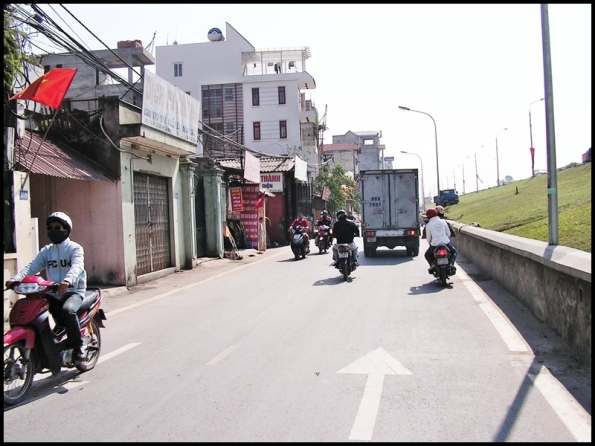
My colleagues Mr Ngan, Mr Vinh and I, we all work for a medium sized travel/tour company owned by young Vietnamese men, often on a Sunday would ride our motor bikes to take a look at some of the historical sites around Hanoi. One such place was Duong Lam Village, one of the oldest in Vietnam. A truly fascinating and beautiful place and it is like stepping back in time seeing and walking around the old original houses. The houses remain exactly the same and the residents are 3rd and 4th generation families. There is a central meeting hall in the middle of the village, open on 3 sides, where there is a large gong to call the villages to a meeting. What always fascinated me is the wonderful terracotta tiles, hand made bricks and small doorways with different carvings on them that make up these buildings. It’s totally unique to Asia and is very peaceful and pleasing to the eye. (Good Feng Shui).
We were invited into one local house by Mr Hai (number two) and his wife for a traditional Vietnamese lunch, prepared probably the same way for centuries, cooked on a small charcoal BBQ, and it was delicious. We had fried tofu, BBQ pork, water spinach with garlic (called morning glory), BBQ chicken (Vietnamese prefer stringy chicken rather than soft and often they call it fighting cock, obviously not a good fighter who lost and ended up being invited to dinner) and a myriad of unusual vegetables. These are always served with dipping saucers ranging from MSG with lime juice, fish sauce and many other tasty home made sauces. Of course there is also a plate of very hot chillies which I still have trouble managing to eat. The hospitality shown by Vietnamese people is great. Always you are offered home made rice wine (poured from a plastic 5 litre container, very warm and delicious but, great headache material if you over-indulge), Fresh fruit consisting of some varieties I have never seen in my country (fruit in Vietnam is sweet and fresh from the tree or vine) and to finish off, green tea served from a small teapot into eggcup style cups. Mmm. Good food! Wonderful friendly delicious and informative hospitality. Traditionally they would sit on the floor but being a chubby westerner (Tay) they thought it better to sit me at a regular table.
The area where they eat is in one main room in the house. This room contains floor sitting area, an altar and a large, very, very hard bed. Sort of like a multi purpose area. The cooking area is usually in a small room off the side of the house (some of the cooking is done in the courtyard on charcoal BBQ’s) and the toilet is usually some distance from the main area (mostly squat style but I have noticed western styles slowly creeping in).
Usually, in the courtyard, there are always many terracotta pots containing different fermenting foods. Some contain rice for wine, other to make sauces or shrimp paste and this area is set aside for this purpose to make some extra money to support the family. Of course they also have some type of fruit or vegetable growing. No space is wasted.
They were very proud to show me their photos of their children, grand children and ancestors. There is usually an altar in every home for ancestral worship. Their altar had photographs of their deceased Mother, Father, Grandparents and great Grandparents. Vietnamese families are very close knit and the children and grandchildren are often looked after by the grandparents while the mother and father go about making a living. This can be going through the village collecting recycling, they may have a small roadside stall selling tea or sticky rice or home made food selling plastic wares (brooms, bowls slippers etc) from the back of an overloaded push bike or labouring in the rice paddies or construction sites.
Next we walked through the village to the oldest house. The owner and his family welcomed us warmly and proceeded to serve tea and show us around the house. Amazing! It has never changed (apart from the western style toilet built outback) since it was built some hundreds of years before. Of course there were some 40 or so large terracotta pots fermenting wine (vodka as they call it) in the courtyard. We sampled this and, WOW, rocket fuel! They proudly showed us some extremely old photographs of their ancestors. Again, like most Vietnamese people, very friendly and welcoming.
The road to the village is very good by Vietnamese standards. You travel along the newly constructed Thang Long Highway and it takes about ¾ to 1 hour. There are full day tours where you also visit some historic Pagodas and include English speaking guide, lunch, any entrance fees and transport (air-conditioned bus or car). A truly cultural, interesting experience to remember the real Vietnam and its people!
Footnote:
Ngan was on the back of my motor bike (very brave man) and on the return to Hanoi, travelling at about 70 to 80 kms an hour, the back tyre punctured. Up until then Ngan seemed reasonably comfortable but I could feeling him grab on when he thought I was going to panic and hit the front brake hard and send us spinning. I didn’t much to his relief. As it was dusk and we were in the middle of rice paddies and villages, we pushed the bike back in to a small village to find someone to help repair the tyre. It obviously was quite spectacle for people coming and going into the village as almost everyone stopped to see or help the westerner. Eventually two very helpful men, one a real character who laughed a lot and a young guy who had his roadside tea and soft drink stall packed two stories high on the back of his bicycle, went around the village to find a new tube and tools to fix it. When it was repaired, they didn’t want to take any money but after a bit of persistence, they finally accepted 50,000 Vietnamese Dong, about $2.50. Once again the friendly and helpful Vietnamese nature comes to the fore.
Cheers

